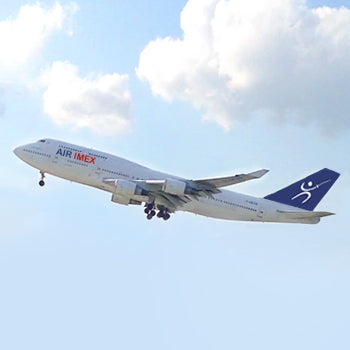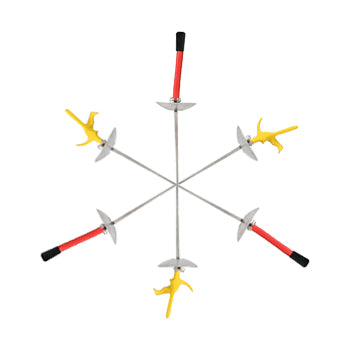What does FIE mean?
Antoine Gouin

The FIE acronym stands for International Fencing Federation (in French). As far as fencing equipment is concerned, the FIE label represents a standard to which the equipment must conform. These standards are defined by the FIE and certified by the CE (a European standard) and are expressed in levels (1 and 2) or in Newtons (N).
What is a Newton?
A Newton is a unit of force. The fencing equipment certification process includes, among other things, attempting to pierce protective clothing and masks with a conical punch. 350N, 800N and 1600N represent the minimum penetrating force that the various pieces of equipment must withstand.
What are the levels of certification / protection?
In the case of protective clothing, there are two levels of certification with the CE, namely Level 1 and Level 2. These levels are also expressed in Newtons (N). The FIE standard corresponds to Level 2. Level 1 clothing and masks are certified for 350N. Level 2 clothing is certified at 800N and masks at 1600N.
What equipment can carry a CE or FIE certification?
All the equipment used in the practice of fencing must comply with the regulations of the FIE (or those of the national or provincial federations), but only certain equipment may / must bear a CE or FIE label, for the following reasons:
- Safety: Protective clothing (jackets, plastrons, pants) must be certified with CE, either Level 1 (350N) or Level 2 (800N).
- Safety: Masks must be certified with CE, either Level 1 (350N) or Level 2 (1600N).
- Safety: Sabre gloves can be Level 2 (800N) certified or not at all. For other gloves, there is no safety standard.
- Compliance: Foil and epee blades may be FIE certified or not at all. Certain standards must be respected in all cases, but a label is not required.
- Compliance: Chest guards for foilists must be covered with a foam that bears the FIE label, which attests to the properties of the foam.
The rest of the fencing equipment is not required to display a mark of conformity. This includes metallic jackets, bodwires, socks and various weapon parts.
Do I absolutely have to buy FIE equipment?
In Canada, FIE fencing equipment is not mandatory in tournaments (even for national championships) except in the following cases:
- FIE tournaments occasionally held in Canada (Panams, Grand Prix, World Cup, etc.)
- The chest protector with the FIE foam layer is required for national and Quebec tournaments (please check the rules that apply to your province)
For training camps and tournaments abroad, specific rules can vary a lot by country / region. For example, in the United States, the FIE sabre glove is mandatory for almost all tournaments. In Italy, full FIE equipment is compulsory even for club training. Refer to our Rules for Equipment for more details, or contact the tournament organizers or the appropriate fencing federation to confirm the applicable rules.
FIE, is this a good buy?
The answer: it depends. If you are not required to purchase FIE equipment, a choice is necessary. Since there are several factors to consider, here is a table that illustrates the relative advantages and disadvantages of both types of equipment.

It is important to note that this table only gives a general idea of the properties of the average of each range, but the specifics will vary between brands and models of equipment. Keep reading, we explain in detail everything you need to know to make the right choice.
Protective clothing
When it comes to protective clothing, there are several factors to consider when choosing a range. Even if you are in a situation where the FIE is not mandatory, the FIE ranges have the advantage of being more comfortable and significantly more durable than the non-FIE ranges for intensive use.
Entry-level FIE clothing is of excellent quality and very durable, but often the fabric is a bit heavier and thicker than non-FIE and high-end FIE. They are very comfortable, well adjusted and can last over a decade if properly cared for.
High-end FIE clothing is designed to be as thin and light as possible. What is gained in breathability and elasticity is also accompanied by a price increase. In addition, the use of exotic materials in their composition makes them more difficult to maintain and also means they have a shorter lifespan. Refer to the product descriptions on our website to know the specifics of each piece of equipment.
In addition to the specific properties of the clothing, there are also other factors to consider before making a choice:
- How many times per week will the equipment be used?
- How intensely do you use it? Are you a beginner? Do you participate in tournaments?
- What is your budget?
- Do you prefer more durable equipment or do you prefer to renew it more often?
- Is it for a young fencer who is growing or for an adult?
- Are you sure your child will be fencing for many years to come?
Masks
FIE masks have a few advantages over non-FIE masks, especially when it comes to how they are made. For all masks, the mesh is made of two pieces, namely the face and the head. These two pieces are held in place by welds. Non-FIE masks are assembled with small, spaced welds (also known as tacks), while FIE masks are welded around the entire perimeter. This makes FIE masks much stiffer and more difficult to deform, for example if the mask ends up under a mountain of luggage at the airport.
The mesh of FIE masks is made entirely of stainless steel, while non-FIE masks are made of ordinary steel plated with zinc or chrome. Over time and after repeated hits, the plating peels and the steel rusts, which is not the case with FIE masks.
Regulations are very strict as to the size of the wire used to make the mesh of the mask, as well as for the space between the wires. On the other hand, the use of ordinary steel for non-FIE masks makes them more likely to dent if they are dropped on the ground or when receiving a direct hit face. The mask remains safe, this is more of an aesthetic concern.
Also, although some non-FIE masks now offer these options, the FIE masks present interesting options such as a removable interior for easy cleaning, or even adjustable padding for perfect comfort. FIE foil and sabre masks also automatically offer a stainless steel bib. To understand why this is a considerable advantage, refer to the article Metallic jackets: Which material to choose?
Gloves
FIE gloves are primarily intended for sabre fencers. They are made of a thicker material than a standard glove and take some getting used to. They are mandatory in some contexts (see our Rules for Equipment page) but, even when they are not mandatory, they offer the advantage of being more durable than other non-certified gloves. On the other hand, they are also warmer and less flexible than traditional gloves.
Blades
To choose a blade, several factors must be considered. The most obvious is the price. Overall, you get what you pay for. With some exceptions, more expensive blades are of better quality and are more durable. The biggest difference between an FIE blade and a non-FIE blade is the way it "feels". FIE blades are generally lighter, better balanced and therefore offer better handling. On the other hand, when it comes to a beginner, non-FIE blades are quite suitable.
FIE blades are made of a steel called Maraging. It is a very specialized alloy which is processed according to a very precise recipe. This steel offers very good resilience (the blade returns to its original shape after a touch), does not rust and is significantly more durable than that of non-FIE blades.
Another advantage of FIE blades is that it is possible to choose the desired flexibility (soft, medium, hard). Blades are graded as they are forged, and their resilience allows them to maintain a precise flexibility for the majority of their life span.
On the other hand, it should be remembered that a fencing blade, even FIE, remains relatively fragile. A wrong move or a hit with too much force can permanently deform the blade or break it. This is often the case with beginners who have not yet mastered their distances.
Conclusion
If you are not required to purchase FIE equipment, take a moment to determine whether the benefits that this equipment brings you justify the additional investment, and whether you will have the time to enjoy these benefits (in the case of a growing child). It is about finding the best balance between price, quality, durability, comfort and performance.



